Wildlife Photographer of the Year Competition Showcases Underwater Images
The 53rd annual Wildlife Photographer of the Year competition brought in almost 50,000 entries from 92 countries, showcasing the scope of the world, both aquatic and terrestrial. Underwater images graced the winners- and finalists circles of almost all of the 16 competition categories.
Jump to gallery
Wildlife Photographer of the Year is developed and produced by the Natural History Museum, London. One-hundred images, selected by an international panel of judges, are being shown at the Wildlife Photographer of the Year exhibition at the museum. The exhibition will be touring the UK and will be on show at the Museum of Texas in March and the Houston Museum of Natural Science in May.
Wildlife Photographer of the Year is the Natural History Museum’s annual showcase of the world's best nature photography and wildlife photojournalism. The awarded images shine a spotlight on nature photography as an art form while challenging us to address the big questions facing our planet.
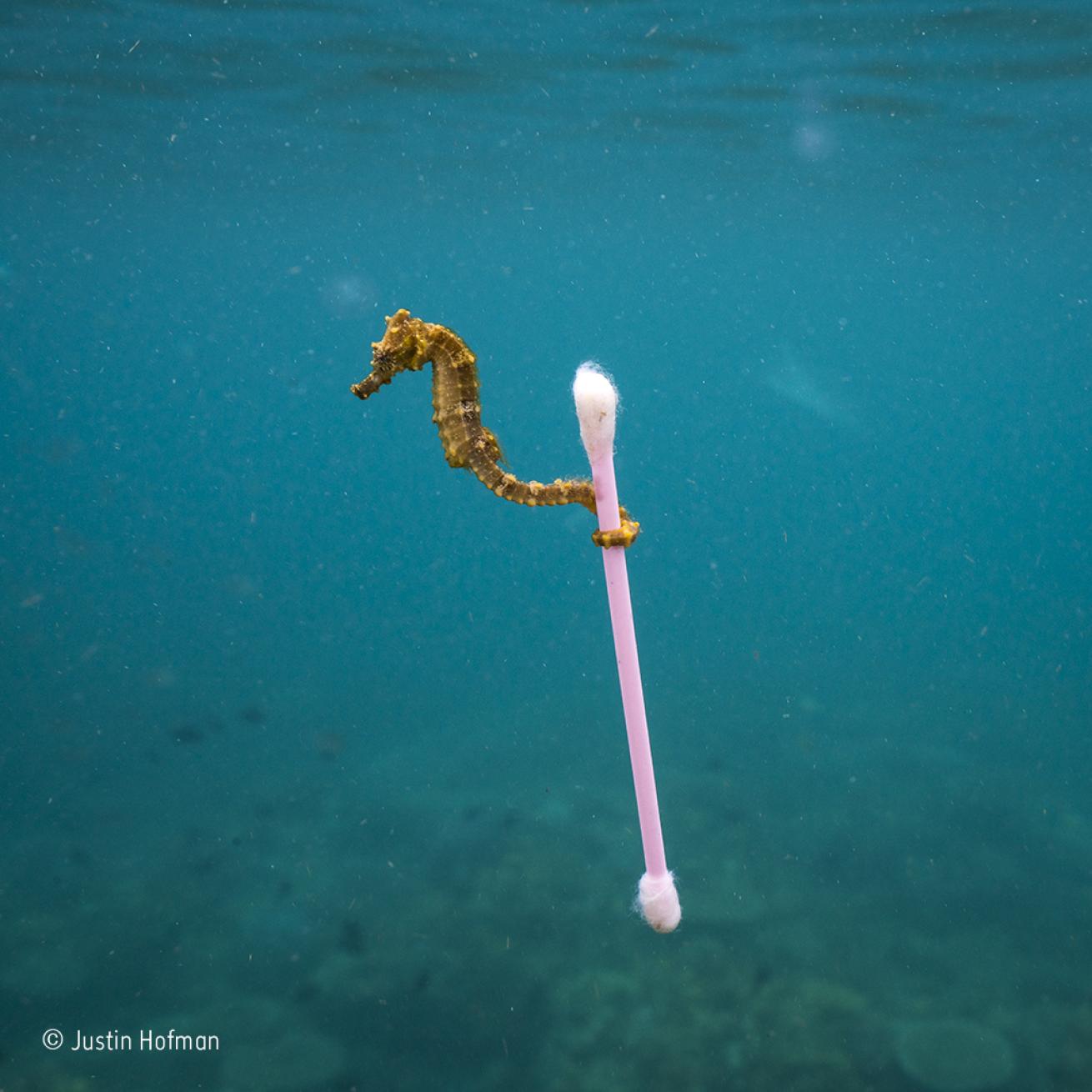
Justin Hofman / Wildlife Photographer of the YearSewage surfer
Finalist: The Wildlife Photojournalist Award: Single Image
Seahorses hitch rides on the currents by grabbing floating objects such as seaweed with their delicate prehensile tails. Justin watched with delight as this tiny estuary seahorse "almost hopped" from one bit of bouncing natural debris to the next, bobbing around near the surface on a reef near Sumbawa Island, Indonesia. But as the tide started to come in, the mood changed. The water contained more and more decidedly unnatural objects – mainly bits of plastic – and a film of sewage sludge covered the surface, all sluicing toward the shore. The seahorse let go of a piece of seagrass and seized a long, wispy piece of clear plastic. As a brisk wind at the surface picked up, making conditions bumpier, the seahorse took advantage of something that offered a more stable raft: a waterlogged plastic cottonbud. Not having a macro lens for the shot ended up being fortuitous, both because of the strengthening current and because it meant that Justin decided to frame the whole scene, sewage bits and all. As Justin, the seahorse and the cottonbud spun through the ocean together, waves splashed into Justin’s snorkel. The next day, he fell ill. Indonesia has the world’s highest levels of marine biodiversity but is second only to China as a contributor to marine plastic debris – debris forecast to outweigh fish in the ocean by 2050. On the other hand, Indonesia has pledged to reduce by 70 percent the amount of waste it discharges into the ocean.
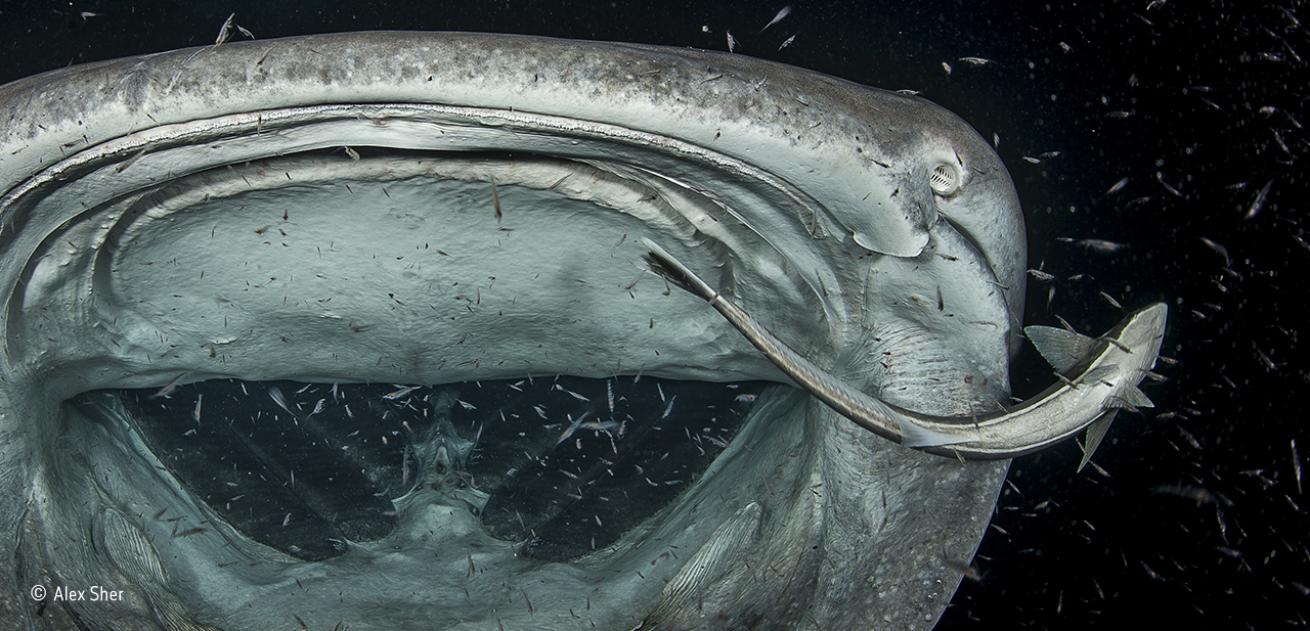
Alex Sher / Wildlife Photographer of the YearBig sucker, little sucker
Finalist: Under Water
"The tricky part for the remora, and me," says Alex, "was staying close enough without being sucked in." The whale shark, off the coast of the Maldives, was sucking in a huge cloud of krill (shrimp-like crustaceans), while a remora was picking them off from the passing stream. Unlike other species of remoras, this slender sharksucker –up to 3 feet long – often swims freely without a host, but it does associate with larger fish, especially sharks, eating their parasites as well as scavenging their prey. Whale sharks, the world’s largest fish – this one being about 29.5 feet long – live on plankton and small fish. Cruising slowly, often near the surface, they suck in water through their remarkably wide mouths and filter out prey as the water passes over their gills. Despite the closure of most commercial whale shark fisheries, this endangered species is still being caught to satisfy the demand for its meat and fins (mainly in Asia) and is also threatened by collisions with ships and entanglement in net fisheries.
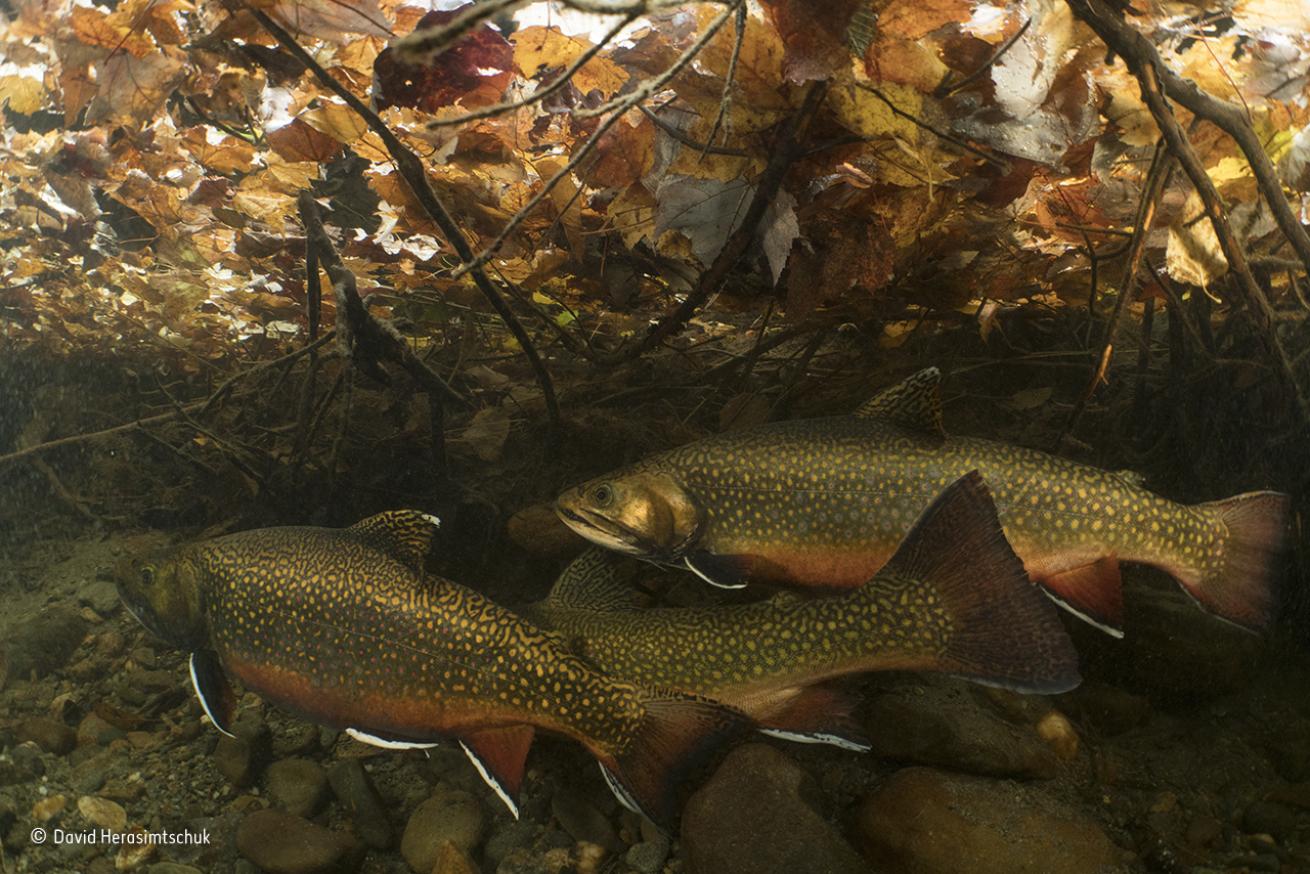
David Herasimtschuk / Wildlife Photographer of the YearSpawn rivals
Finalist: Under Water
In the shallows, cloaked in fallen leaves, two large male brook trout size each other up as they attempt to court the female between them. David had been daily scouting the Magalloway River in Maine for signs of the trout spawning, which they do every autumn in small streams and rivers across New England. Territorial disputes between two or more males are frequent and chaotic – rivals block, bite and ram each other – while the female gets on with digging a nest (a redd) in the gravel, where she will lay her eggs. David often broke through surface ice to lie motionless for hours in the freezing water, allowing the fish to get used to his presence. On a breezy day, tumbling leaves were swept against the bank above one female’s nest. David eventually got close enough to capture the rivalry between her finely patterned suitors, revealing the autumn hues hidden underwater. This North American trout, with its distinctive white-edged fins, is in decline, largely due to habitat loss and degradation, but collaborative conservation efforts, which David supports with his images, aim to curb this.
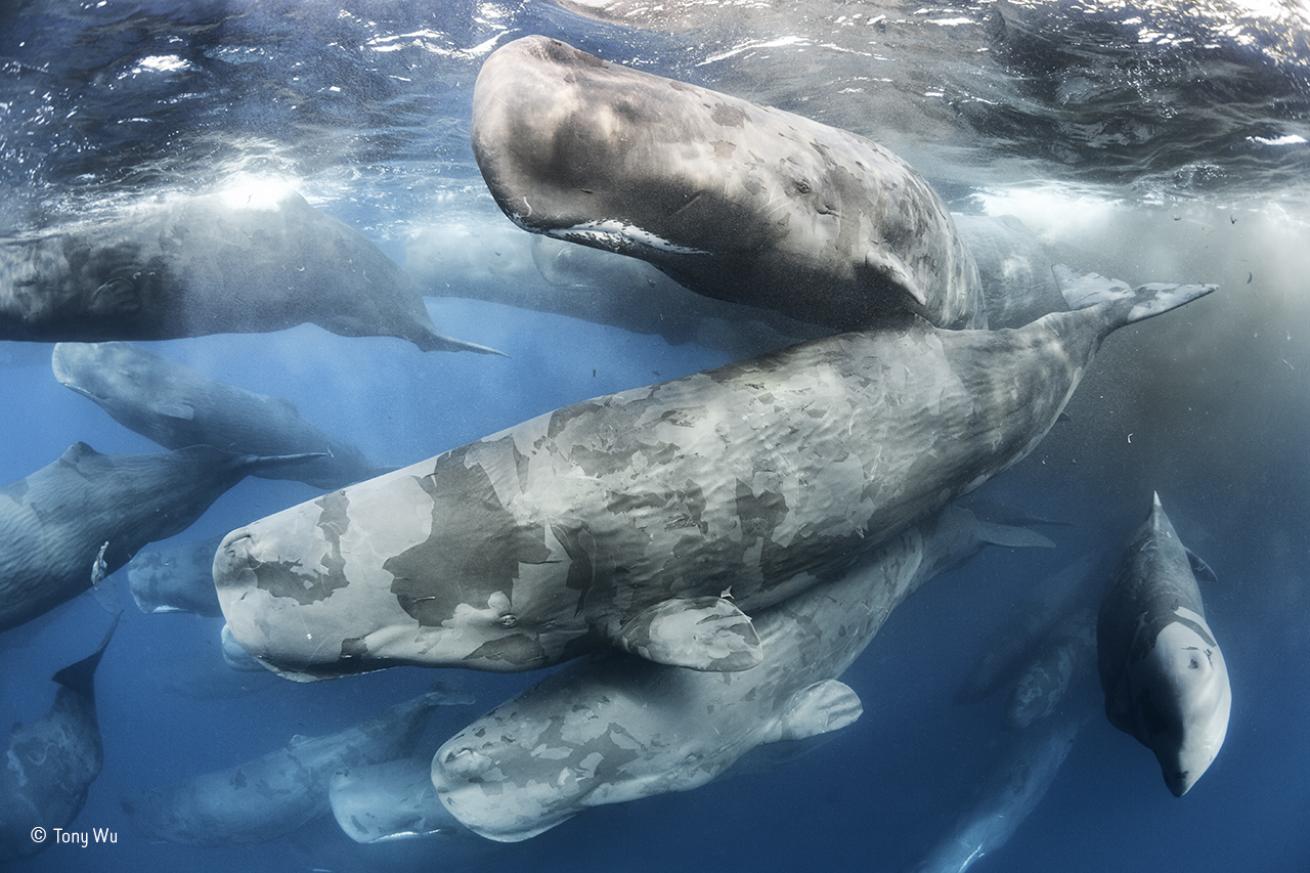
Tony Wu / Wildlife Photographer of the YearGiant gathering
Winner: Behaviour: Mammals
Dozens of sperm whales mingled noisily off Sri Lanka’s northeast coast, stacked as far down as Tony could see. This was part of something special – a congregation of dozens, perhaps hundreds, of social units, like a kind of gathering of the clans. Sperm whales are intelligent, long-lived and gregarious, and groups play, forage, interact and communicate in different ways and have distinctive cultures. Aggregations like this could be a critical part of their rich, social lives but are rarely reported. Some two-thirds of the sperm whale population was wiped out during the peak of industrialized whaling in the 20th century. But commercial whaling was banned in 1986, and this kind of major gathering could be "a sign that populations are recovering," says Tony, who has spent 17 years studying and photographing sperm whales. Tactile contact is an important part of sperm whale social life, but rubbing against each other also helps slough off dead skin. So the water was filled with a blizzard of skin flakes. More photographically challenging was the smearing of the camera-housing dome with oily secretions from the whales and thick clouds of dung released as they emerged from the gigantic cluster. But through continually swimming to reposition himself and the tolerance of the whales themselves, Tony got a unique photograph of the mysterious Indian Ocean gathering.
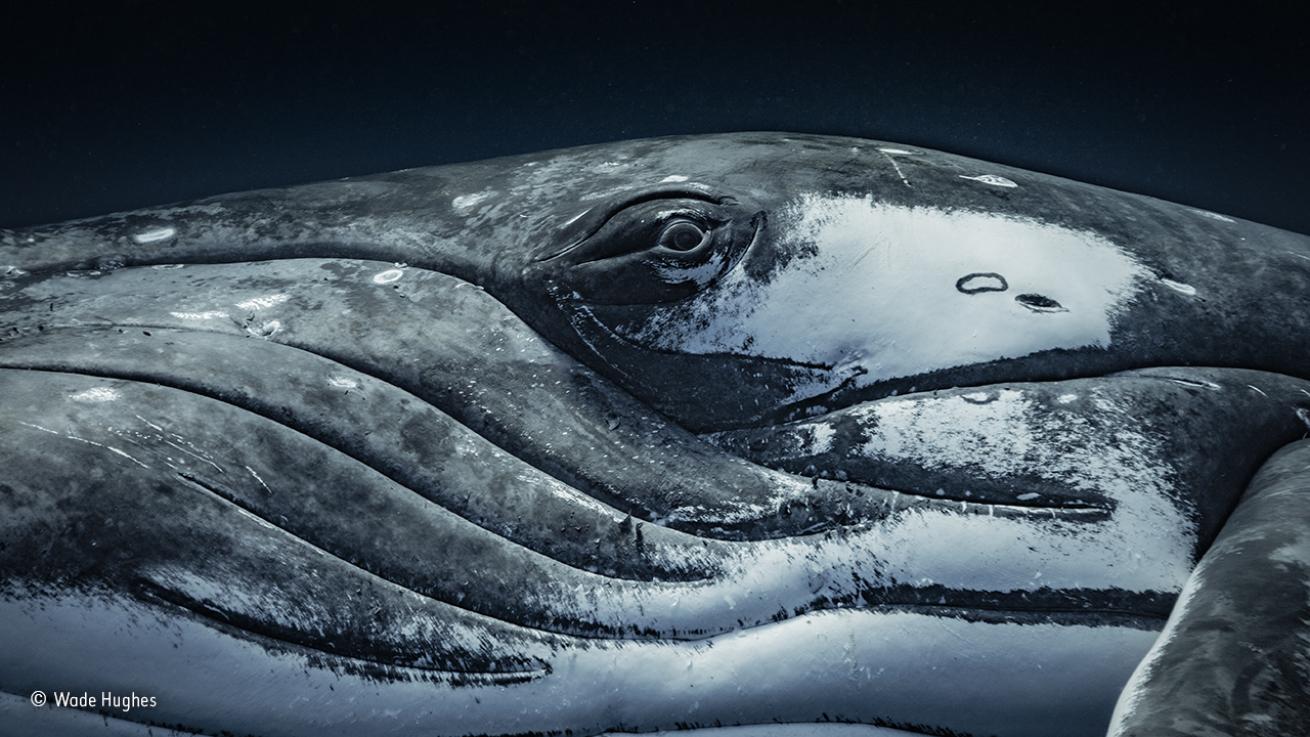
Wade Hughes / Wildlife Photographer of the YearThe look of a whale
Finalist: Animal Portraits
The female humpback whale repeatedly cruised past Wade, each pass slow and measured – once so close that he could have touched her. She was sizing him up to see if he posed any potential risk to her young calf watching him a little way off. Wade was snorkeling off Tonga’s Vavaʻu Islands, a nursery for humpbacks. The females give birth there, and the calves build up their strength and learn to dive, relatively safe from killer whales. Being the subject of her searching, intelligent gaze was, he says, "humbling," and he knew full well that, despite her great size-some 33 feet long – she was surprisingly agile and capable of defending her calf against any perceived threat. This vigilant mother was part of a group that had migrated north from the Antarctic to overwinter in the warm (but food-poor) Pacific waters. They effectively fast here, but the calves, suckling on their mothers’ fat-rich milk, rapidly put on weight. Once the calves are big enough, their mothers lead them on the more than 3,730-mile journey back south to the Antarctic feeding grounds to feast on krill. ‘With a close-up portrait, I wanted to capture something of the intensity of her look and her intelligence,’ says Wade. Once she had checked him out and had satisfied herself that he was harmless, she allowed her calf to come closer so that it, too, could satisfy its curiosity.
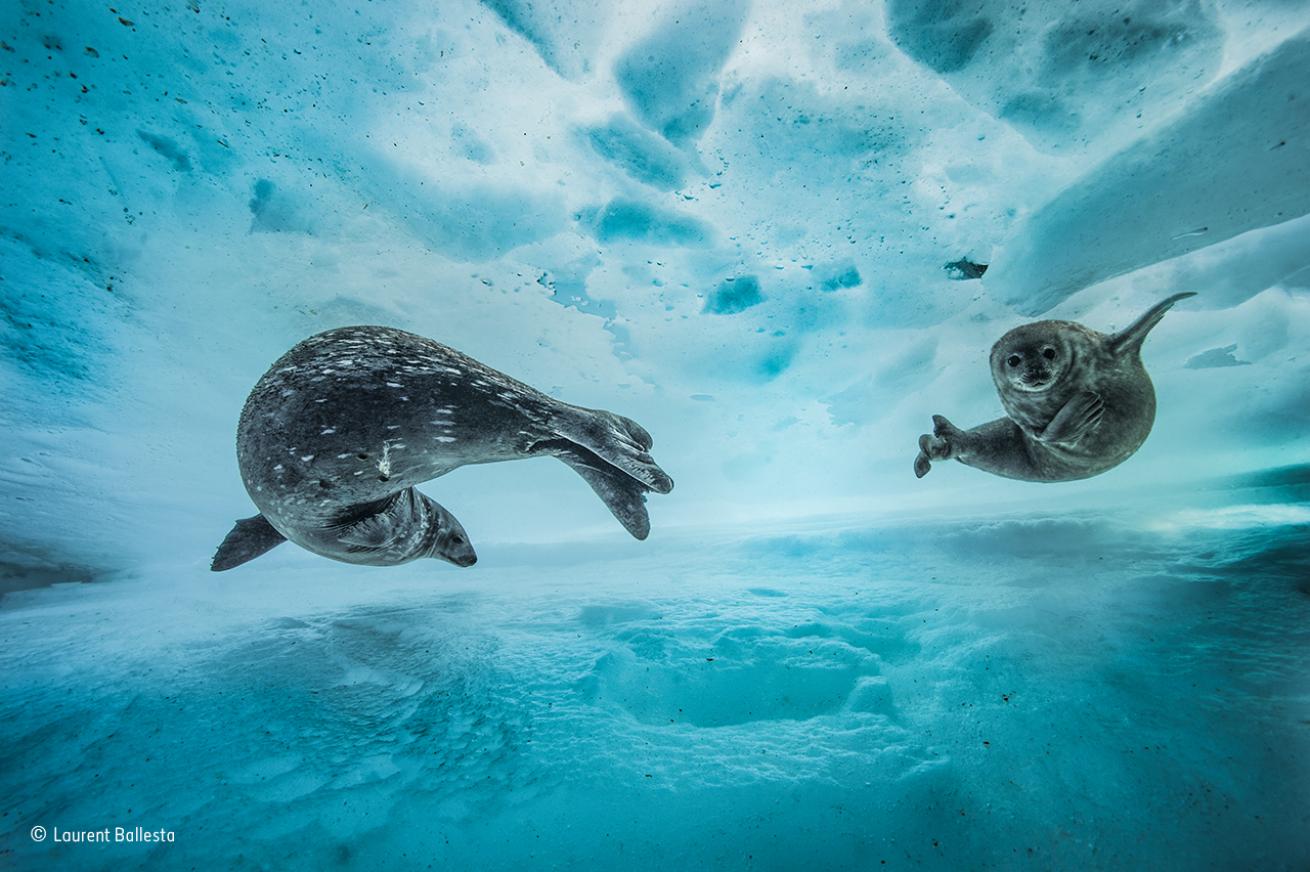
Laurent Ballesta / Wildlife Photographer of the YearSwim gym
Finalist: Behaviour: Mammals
"We were still a few metres from the surface, when I heard the strange noises," says Laurent. Suspecting Weddell seals – known for their repertoire of at least 34 different underwater call types – he approached slowly. It was early spring in east Antarctica, and a mother was introducing her pup to the icy water. The world’s most southerly breeding mammal, a Weddell seal gives birth on the ice and takes her pup swimming after a week or two. The pair, unbothered by Laurent’s presence, slid effortlessly between the sheets of the frozen labyrinth. Adults are accomplished divers, reaching depths of more than 1,970 feet and submerging for up to 82 minutes. "They looked so at ease, where I felt so inappropriate," says Laurent. Relying on light through the ice above, he captured the curious gaze of the pup, the arc of its body mirroring that of its watchful mother.
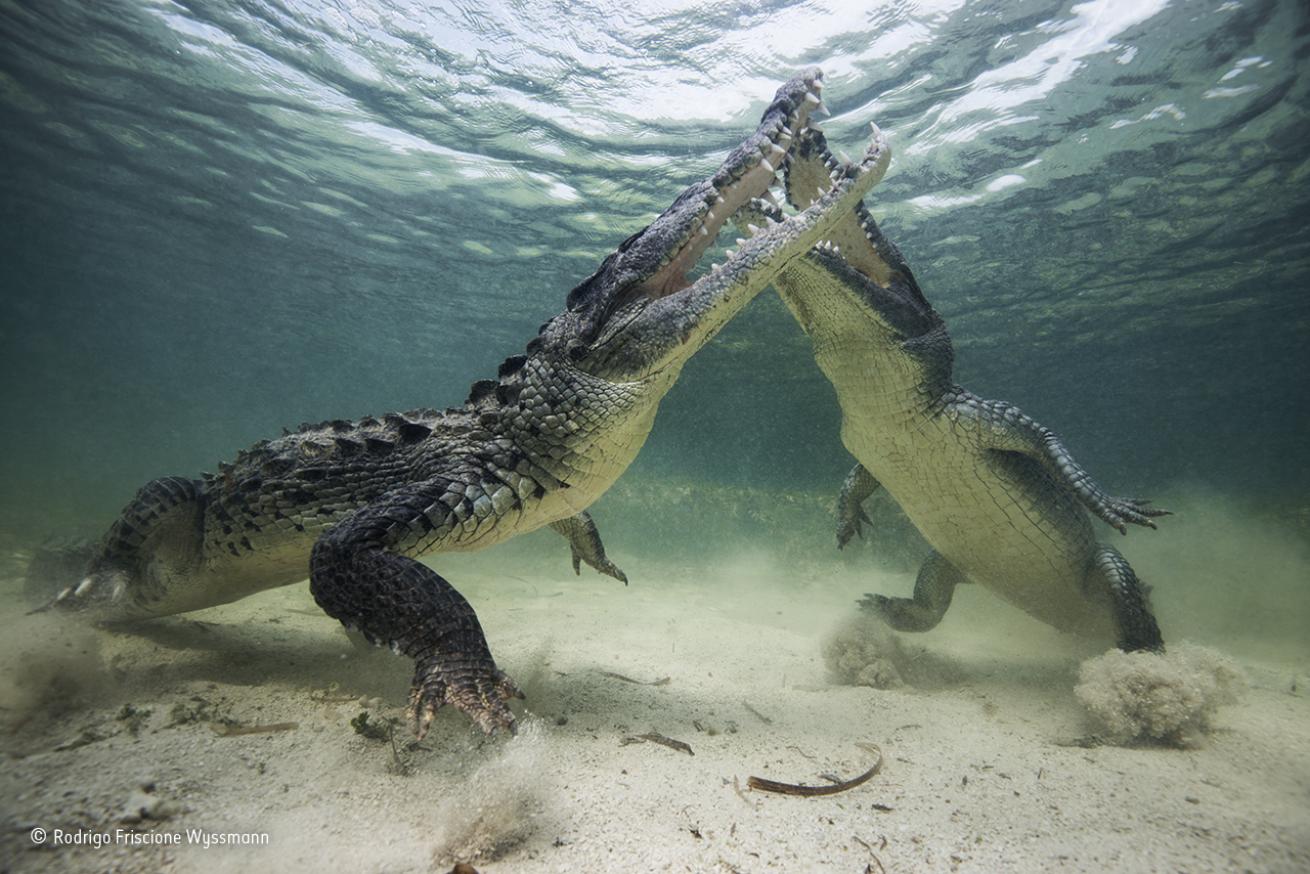
Rodrigo Friscione Wyssmann / Wildlife Photographer of the YearSnap shot
Finalist: Behaviour: Amphibians and Reptiles
In the shallows of Mexico’s Chinchorro Bank Biosphere Reserve, two American crocodiles – both about 10 feet long – faced off. Just before the rivals lunged at each other, Rodrigo submerged, holding his breath. Powered by their strong legs and muscular tails, jaws snapping, the crocodiles went for each other’s throat and eyes. Though American crocodiles are territorially aggressive, combat under water is rarely witnessed. Smaller crocs usually give way to larger ones – and this fight lasted just seconds before the intruder backed down. But lying on the sand with his camera pre‑set to shoot into the surface light, his strobes aimed downwards to minimize backscatter (caused by illuminated particles), Rodrigo captured the clash and got the shot he had dreamed of for years.
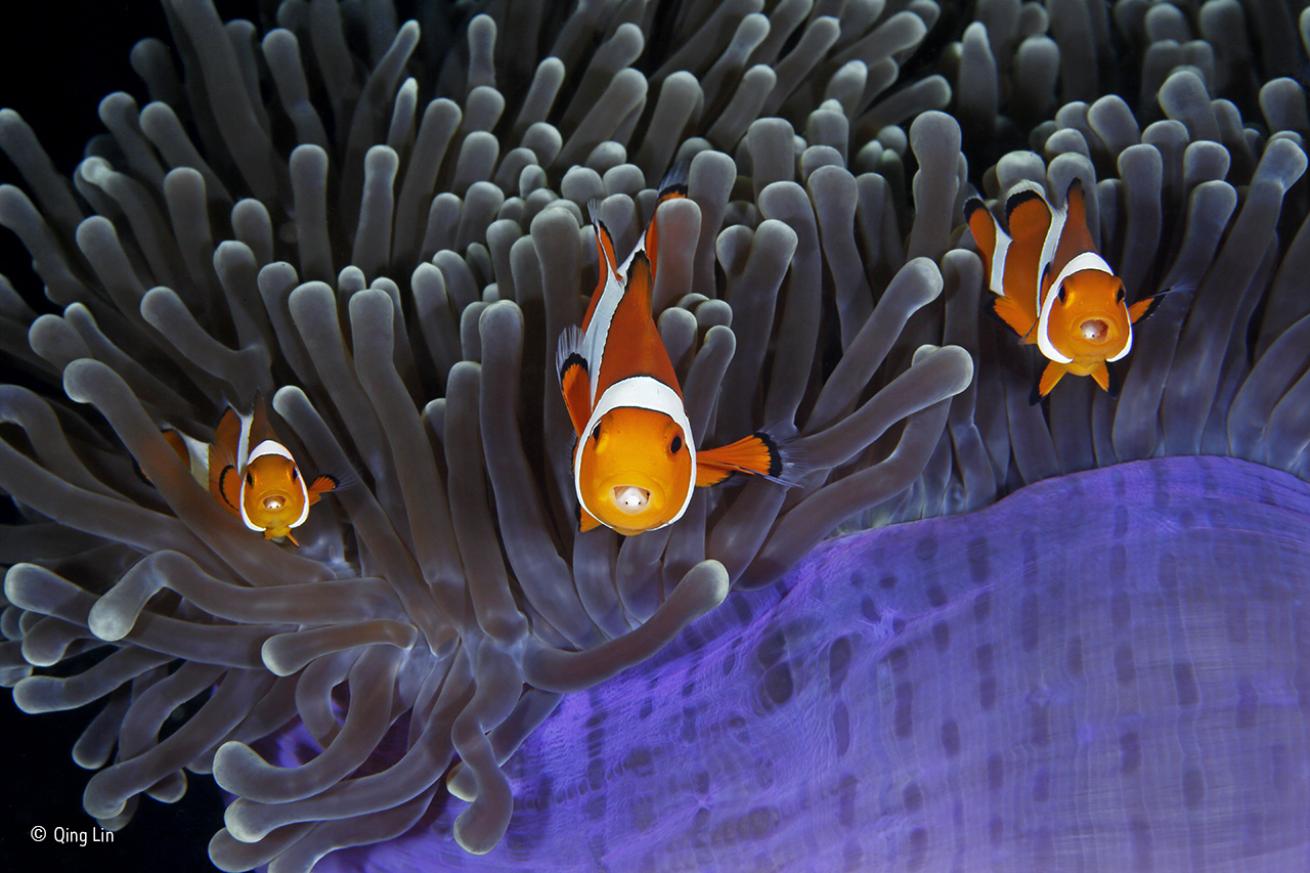
Qing Lin / Wildlife Photographer of the YearThe insiders
Finalist: Under Water
The bulbous tips of the aptly named magnificent anemone’s tentacles contain cells that sting most fish. But the clown anemonefish goes unharmed thanks to mucus secreted over its skin, which tricks the anemone into thinking it is brushing against itself. Both species benefit. The anemonefish gains protection from its predators, which daren’t risk being stung, and it also feeds on parasites and debris among the tentacles; at the same time, it improves water circulation (fanning its fins as it swims), scares away the anemone’s predators and may even lure in prey for it. While diving in the Lembeh Strait in North Sulawesi, Indonesia, Qing noticed something strange about this particular cohabiting group. Each anemonefish had an extra pair of eyes inside its mouth – those of a parasitic isopod (a crustacean related to woodlice). An isopod enters a fish as a larva, via its gills, moves to the fish’s mouth and attaches with its legs to the base of the tongue. As the parasite sucks its host’s blood, the tongue withers, leaving the isopod attached in its place, where it may remain for several years. With great patience and a little luck – the fish darted around unpredictably – Qing captured these three rather curious individuals momentarily lined up, eyes front, mouths open and parasites peeping out.
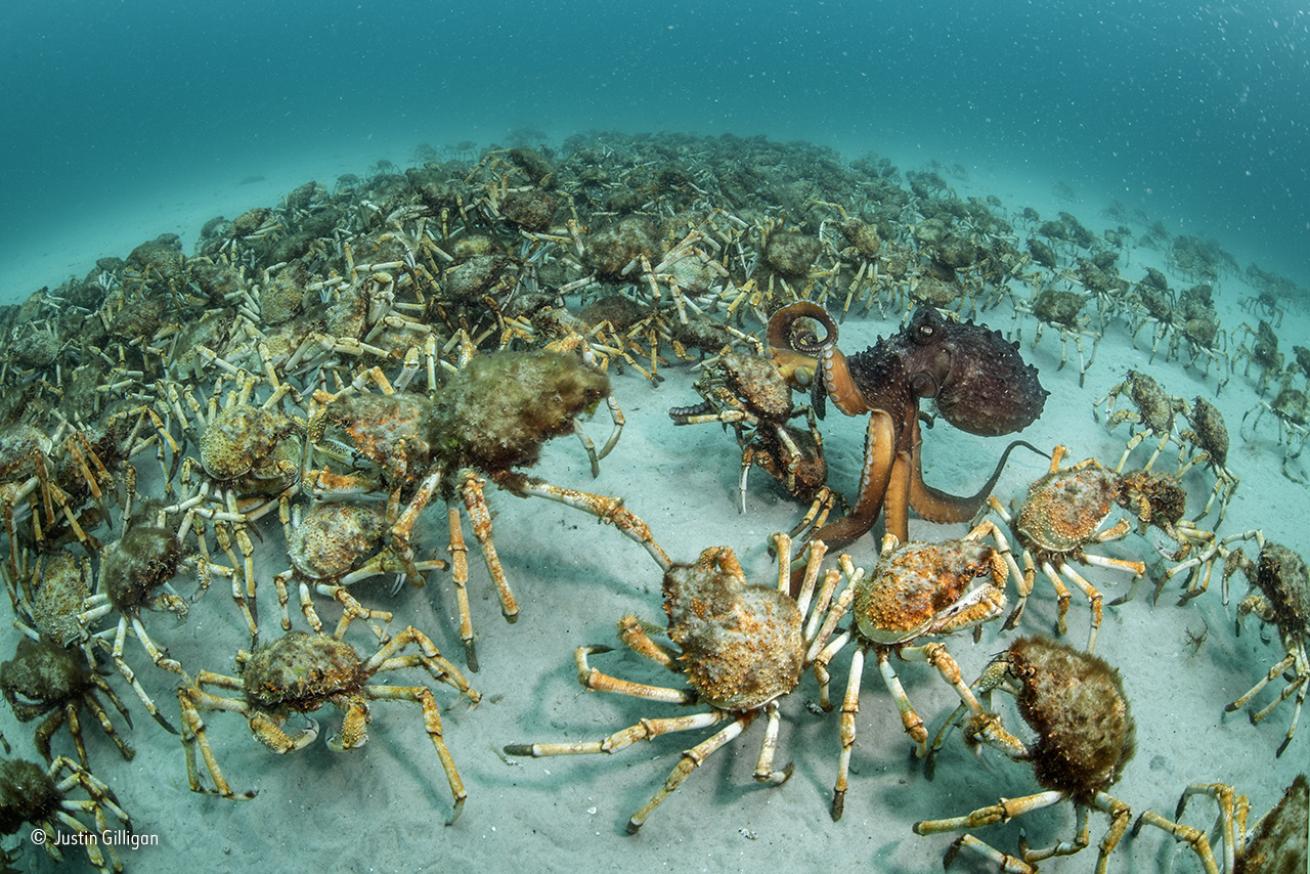
Justin Gilligan / Wildlife Photographer of the YearCrab surprise
Winner: Behaviour: Invertebrates
Out of the blue, an aggregation of giant spider crabs the size of a football field wandered past. Known to converge in their thousands elsewhere in Australian waters –probably seeking safety in numbers before molting – such gatherings were unknown in Mercury Passage off the east coast of Tasmania. Justin was busy documenting a University of Tasmania kelp transplant experiment and was taken completely by surprise. A single giant spider crab can be hard to spot – algae and sponges often attach to its shell, providing excellent camouflage – but there was no missing this mass march-past, scavenging whatever food lay in their path on the sandy sea floor. "About 15 minutes later, I noticed an odd shape in the distance, moving among the writhing crabs," says Justin. It was a Maori octopus that seemed equally delighted with the unexpected bounty. Though large – the biggest octopus in the southern hemisphere, with muscular arms spanning up to 10 feet and knobbly, white-spotted skin – it was having trouble choosing and catching a crab. Luckily for Justin, the stage was set with clear water and sunlight reflecting off the sand. He quickly adjusted his camera and framed the octopus finally making its catch.










